It is only in recent studies of Byzantine music that composers of medieval Byzantine chant have been examined.1 Not unlike composers of Western medieval music such as Leonin, Perotin, and Machaut, little is known about most Byzantine musicians. Nevertheless, renowned Byzantine musicians and composers of the late Middle Ages did exist, even though a majority of these musicians will forever remain only as names in the folios of the musical manuscripts. A few of the composers most frequently mentioned are Ioannes Koukouzeles,2 Ioannes Kladas, Xenos Korones, and Manuel Chrysaphes.3 As might be expected of medieval times, the composers from both the East and the West were predominantly men. In my investigation of medieval Byzantine chant, however, I have found references to two women composers: one outstanding in importance and the other limited in importance because of her one reference. It is the aim of this study to identify and discuss the works of these composers of Byzantine music.
| * | * | * |
It is not uncommon in Byzantine musical manuscripts to identify a composer by profession or place of origin. In several instances composers have even been identified by a family name which has a long standing tradition of musicians. It is in this fashion that one of our women composers is identified. The one and only musical composition and inscription in reference to this composer appears in Athens MS. 2406, folio 258v. The composer is identified by the family name and the relationship of the composer to the patriarch of the family. The inscription reads: "It is said that this [composition] is [written] by the daughter of Ioannes Kladas."4 It is interesting that in the single reference to this woman composer, no given or Christian name is indicated. In instances where male members of a family are cited, a given name as well as a family relationship is usually included.5 From this reference it appears that the daughter of Ioannes Kladas was probably known as a singer and composer.6 Her fame is not as renowned as that of her father who was a leading composer of Byzantine chant of the late fourteenth century as well as the "Lampadarios" or maistor of the Hagia Sophia of Constantinople.7
Based on the dates of Ioannes Kladas, the composition by his daughter would be dated around the late fourteenth or early fifteenth century. The composition is included in a section of the manuscript that contains a collection of compositions by Ioannes Kladas—thus possibly suggesting a dual authorship of father and daughter. The selection attributed to the daughter is an antiphon from the octoechos and appears in the section of chants in Mode IV Authentic. A transcription of this selection may be found in Example 1.
Example 1: An Antiphon by the Daughter of Ioannes Kladas
| Mode IV Authentic | Transcription from Athens MS. 2406, f. 258v by D. Touliatos-Banker |
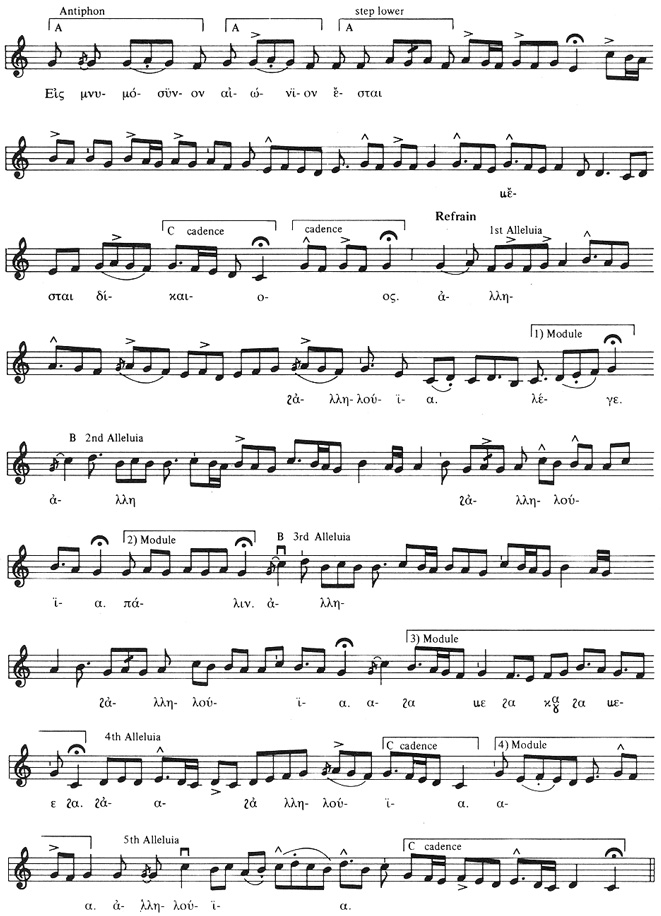
Since this antiphon is the only composition thus far attributed to the daughter of Ioannes Kladas, it serves as the only source of style for the composer.
The setting of the antiphon is not complex in construction. The opening is structured on the motive GGAGF, a typical formula for Mode IV Authentic, which is set almost syllabically. The motive is stated consecutively three times, but in its third appearance it begins a step lower. These repetitions are indicated in Example 1 by the lettered horizontal brackets identified as A. After the three statements of the formula, the remaining setting of the antiphon and its refrain is melismatic. The refrain accompanying the antiphon is set to an Alleluia text stated five times. Note that each statement of the refrain is interpolated by a module. After the first statement, a connecting module with the text  (say) follows. A
(say) follows. A  module is a device used to connect different sections of a chant and also in this instance intones the starting pitch of the next statement. The second statement is followed by a
module is a device used to connect different sections of a chant and also in this instance intones the starting pitch of the next statement. The second statement is followed by a  or "Repeat" module. As might be expected this module introduces the third statement which is an exact repetition of the second. In the example the sections identified as B mark this similarity. The third and fourth modules separating the fourth and fifth Alleluia statements consist of melodic fragments set to intercalated or nonsensical syllables.
or "Repeat" module. As might be expected this module introduces the third statement which is an exact repetition of the second. In the example the sections identified as B mark this similarity. The third and fourth modules separating the fourth and fifth Alleluia statements consist of melodic fragments set to intercalated or nonsensical syllables.
A double cadence concludes the setting of the antiphon proper. The second cadence which precedes the refrain is composed of a GFGFG motive that brings that portion of the chant to a close on the final, G. However, the refrain of the chant does not end on the expected final but rather a fifth lower on C. The cadential formula is a pentachord G to C, which is identified with the lettered brackets C in Example 1. In the final cadence of the refrain, this formula appears in an extended sequential form. In its five-note form, it is the cadence for the fourth Alleluia statement and is the first of a double cadence for the setting of the antiphon proper.
Besides the daughter of Ioannes Kladas the only other woman composer of medieval Byzantine chant is Kassia. She is identified in the service books and manuscripts by the various forms of her name:  ,
,  ,
, , and
, and  .8 Unlike the daughter of Kladas for whom we have little information, there is no lack of information concerning Kassia. A gifted composer and poetess, the woman is a historical figure whose name is found in the chronicles of the Byzantine empire. Kassia is perhaps best known for her participation in the brideshow of Emperor Theophilos. According to the story Kassia, who was one of the most beautiful and highly educated women of the empire, was brought to the brideshow of Theophilos where he would select his bride-to-be with a token of a golden apple. Before presenting the golden apple, Theophilos screened his candidates by testing their intelligence and wit. This incident is best described by Edward Gibbon in the following passage.
.8 Unlike the daughter of Kladas for whom we have little information, there is no lack of information concerning Kassia. A gifted composer and poetess, the woman is a historical figure whose name is found in the chronicles of the Byzantine empire. Kassia is perhaps best known for her participation in the brideshow of Emperor Theophilos. According to the story Kassia, who was one of the most beautiful and highly educated women of the empire, was brought to the brideshow of Theophilos where he would select his bride-to-be with a token of a golden apple. Before presenting the golden apple, Theophilos screened his candidates by testing their intelligence and wit. This incident is best described by Edward Gibbon in the following passage.
With a golden apple in his hand he [Theophilos] slowly walked between two lines of contending beauties; his eye was detained by the charms of Icasia, and, in the awkwardness of a first declaration, the prince could only observe that in this world, women had been the occasion of much evil [in reference to Eve, the first created woman]: "And surely, Sir," she [Kassia] pertly replied, "they have likewise been the occasion of much good" [in reference to the Virgin Mary]. This affectation of unseasonable wit displeased the imperial lover; he turned aside in disgust; Icasia concealed her mortification in a convent, and the modest silence of Theodora was rewarded with the golden apple.9
To Theophilos the readiness of Kassia's answer demonstrated a lack of modesty and a quickness of wit far greater than his own. Although Kassia lost the opportunity to become empress it is she who captured Theophilos' heart.
It is believed that Kassia was born around A.D. 810; her death date is uncertain.10 Her compositions were written during the reign of Theophilos (829-42) and his son Michael (842-67). She wrote in a period that was contemporary with the famous hymnographers from the monastery of Studios, including such composers as Theodore of Studite, Joseph of Thessalonika, and St. Theophanes. Mostly known as a composer of sacred poems, Kassia was also a writer of secular poems which were epigrams and moral sayings.11
There is some doubt concerning the authenticity of some of Kassia's melodies. Moreover, it has been questioned whether Kassia wrote music as well as text for her liturgical poems. According to the practice of the earlier hymnographers, Romanos Melodos and John of Damascus, it appears to have been a tradition that the hymnographer wrote both words and music.12 It was believed that a sacred metrical poem accompanied by music would be more effective.13 Besides composing music to her own liturgical poetry, Kassia is also known for having composed music to the poetry and prose of Byzantios, Georgios, Kryprianos, and Marcos Monachos.14
In Table 1 a catalogue of the types of compositions along with the incipits, modes, and occasions for which the chants of Kassia are performed may be found. The listing also includes the source of attribution for Kassia as well as other possible attributions. Of the 49 liturgical compositions attributed to Kassia, 23 (Nos. 1-23) are considered to be genuine compositions while 26 (Nos. 24-49) are of doubtful authorship.15
TABLE I
LITURGICAL COMPOSITIONS OF KASSIA
A. Genuine Compositions
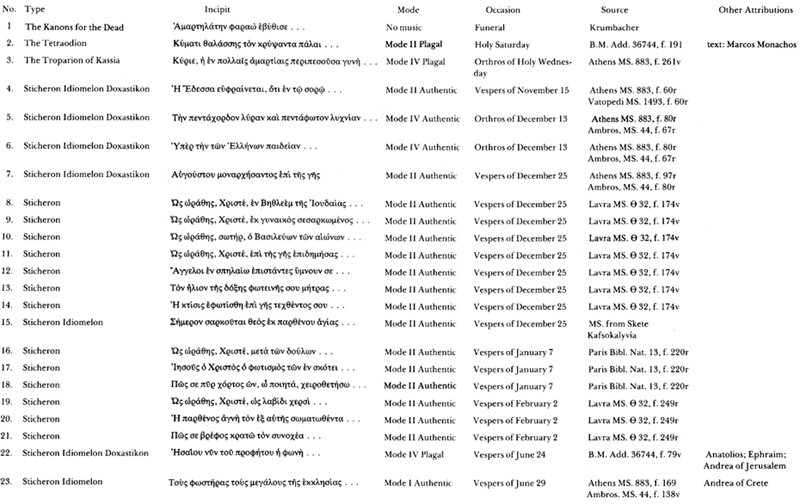
TABLE I
LITURGICAL COMPOSITIONS OF KASSIA
B. Compositions of Doubtful Authorship
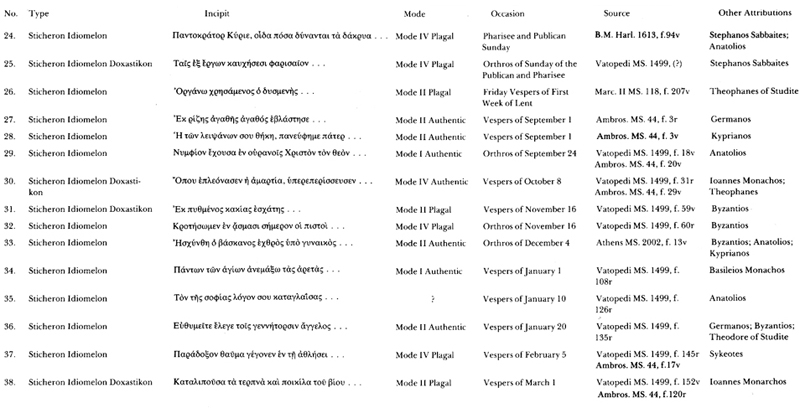
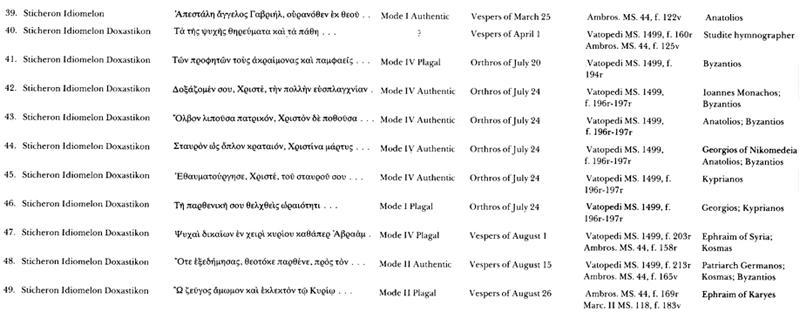
With the exception of the first three compositions in Table 1, all of Kassia's music falls under the category of the Sticheron. In Byzantine music a Sticheron is a lengthy verse changed in various parts of the morning and evening office. A Sticheron Idiomelon has its own melody composed specifically for a verse, as opposed to a melody which is shared by other Stichera.16 A Doxastikon applies to a Sticheron which glorifies or commemorates various saints or martyrs.
Of those compositions not classified as a Sticheron, no music has survived for No. 1 The Kanons for the Dead, chanted during funeral services. All that remains is the text which is attributed to Kassia by the chroniclers and which has been published by Karl Krumbacher.17 In No. 2 The Tetraodion, Kassia has been credited only with the composition of the music to four of the Odes sung in the Kanons of Holy Saturday. The text is by Marcos Monachos. The remaining composition, not a Sticheron, is No. 3 The Troparion of Kassia, which is her most famous composition and which will be discussed below.
Although Stichera Nos. 22 and 23 are categorized as Part A. Genuine Compositions, they have also been ascribed to other composers. In the case of No. 22, the hymn has also been credited to Anatolios, Ephraim, and Andrea of Jerusalem. It is believed in this instance that the original melody and text is by Kassia but that the other composers have either embellished or varied her pre-existing melody with their own interpretation. The same holds true for Sticheron No. 23, which is attributed to Andrea of Crete, although most Sticherarion manuscripts credit Kassia with true authorship. This technique of arranging a pre-existing, traditional chant by other composers was a common practice in Byzantium. Nos. 24-49 are all Stichera which are attributed to Kassia but also to various other composers. Some of the manuscript sources which credit Kassia as composer are listed in Table 1 but because multiple attributions may be found in other manuscripts, those chants which present a contradiction are placed under Part B. Compositions of Doubtful Authorship.
Since most of Kassia's liturgical compositions are Stichera, most of her works are performed in the evening and morning office throughout the liturgical year. A tabulation of the occasions of performance in Table 1 will show that the majority of the hymns are performed in the vespers service. Also, from Table 1 a modal pattern can be derived for her compositions. Even though there is a variance between the plagal and authentic modes, two modal areas are more frequently used in Kassia's compositions, the deuteros and tetartos. This predominance is not coincidental; these two modal areas were the most frequently used in the liturgical chants from the earliest times.18 The exceptions to these two modal centers are the Modal I area used in Stichera Nos. 23, 29, 34, 39 and 46 and Nos. 35 and 40, where no mode is indicated.
Although many sources credit Kassia with authorship, the sources in Table 1 are based on some of the manuscripts identified by Ilse Rochow and H.J.W. Tillyard.19 This documentation is far from complete, however, for nearly every Sticherarion manuscript contains her works.
Because of the length and complexity of Kassia's liturgical compositions, it is impractical to discuss in detail the 49 hymns in the present study. Consequently, analyses will concentrate on three selected hymns from the list of genuine compositions in the hope of determining characteristics of her style.
The first example is one of Kassia's popular melodies, Augustus, the Monarch (No. 7 in Table 1). It is documented in the chronicles of Byzantium that even in Byzantine times this Sticheron Idiomelon Doxastikon in Mode II Authentic was well-known.20 In the text of this Sticheron for Christmas, Kassia parallels the rule of Augustus, the Monarch, with that of Christ. Besides the parallelism of the themes, there is a parallel metrical rhyming scheme in the text which corresponds to the parallelism in the music. In fact it is the construction of the text which influences the structure of the melody. In Example 2 it can be seen that the melody is made up of three phrases, each immediately repeated, and a fourth unrepeated phrase.
Example 2: "Augustus, the Monarch"
| Mode II Authentic | Transcription from Athens MS. 833, f. 97r by D. Touliatos-Banker |
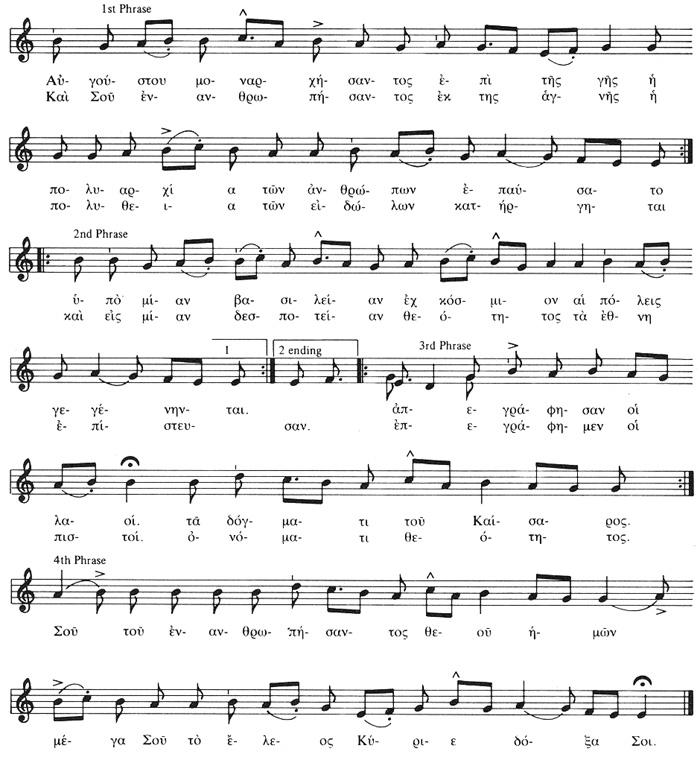
"When Augustus became monarch upon earth,
The multitude of kingdoms among men was ended.
And when Thou wast incarnate of the Holy One,
The multitude of divinities among the idols was put down.
Beneath one universal empire have the cities come,
And in one divine dominion the nations believed.
The folk were enrolled by the decrees of the emperor,
We, the faithful, have been inscribed in the name of Deity.
Oh, Thou our incarnate Lord,
Great is Thy mercy, to Thee be glory."
Translation: H.J.W. Tillyard
The structure of this melody aabbccd follows one of several patterns for the sequence form. It is from the structure found in this Sticheron that it is assumed by some scholars that the sequence was brought from Byzantium to the West.21 Although this claim is difficult to prove, it is safe to assume that the sequence form was used in both the East and the West.
Another composition The Five-stringed Lute and Fivefold Lamp (No. 5 in Table 1) is of interest not only for its music but more importantly for its text. In this Sticheron Idiomelon Doxastikon, Kassia displays her wit with a play on words that demonstrates her reputation as a gifted poetess. This hymn is sung in the morning office of December 13 in commemoration of the five martyrs Eustratios, Auxentios, Eugenios, Orestes, and Mardarios. Since the hymn commemorates these martyrs, their names appear in the text. In Example 3 the names of the martyrs are underscored twice.
Example 3: "The Five-stringed Lute and Fivefold Lamp"
| Mode IV Authentic | Transcription from Athens MS. 833, f. 80r by D. Touliatos-Banker |
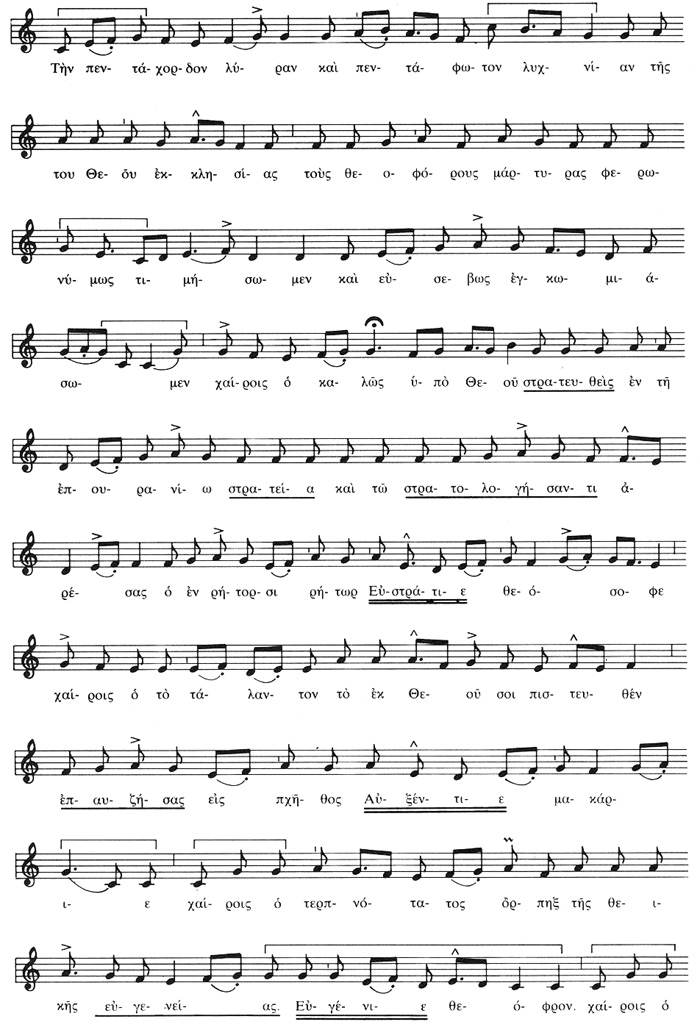
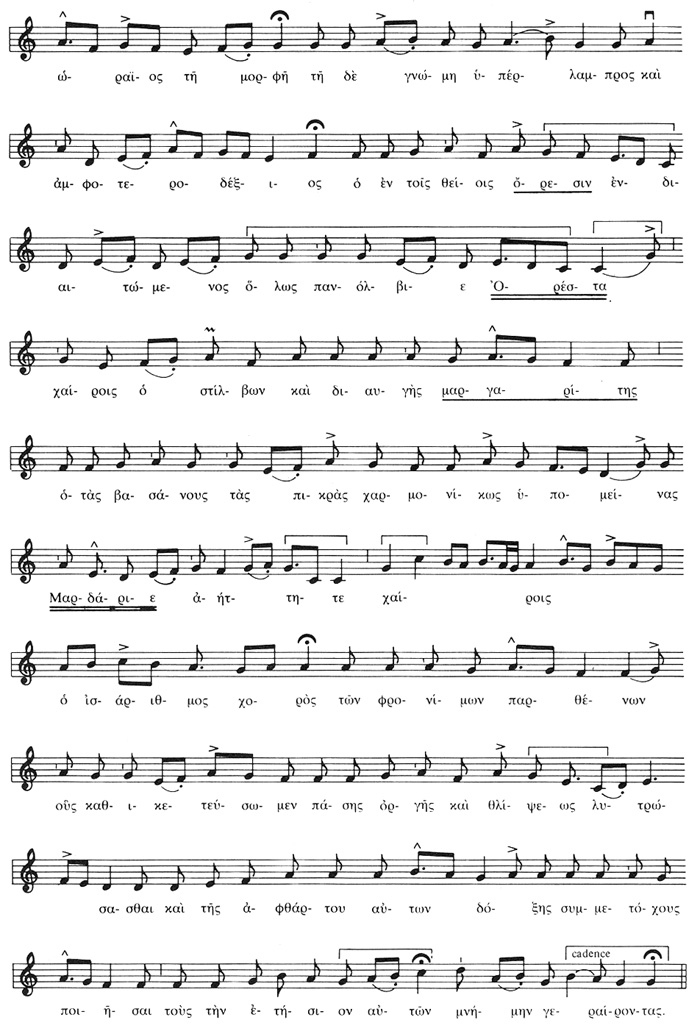
"The five-stringed lute and fivefold lamp of God's Church, even the
martyrs, heralds of God,
Let us mindfully honor and reverently praise.
Hail, thou noble soldier under the Lord, well-pleasing to thy Leader,
orator among orators, Eustratius, wise unto God.
Hail, thou that didst increase unto wealth the talent entrusted to thee
of God, blessed Auxentius.
Hail, thou goodliest scion of God's nobility, godly-minded Eugenius.
Hail, thou fair in form, but in wisdom exceeding bright and ready, living
ever on the mountains of God, all-blessed Orestes.
Hail, thou shining and radiant pearl, who didst abide the bitter
pains victoriously, unconquered Mardarius.
Hail, like-numbered band of wise virgins.
These let us supplicate to deliver from all wrath and persecution,
And to make partakers of their unspeakable glory,
Them that keep their yearly feast."
Translation: H.J.W. Tillyard
What is unusual in this text is the use of words that are etymologically related to the names of these martyrs. In the text Kassia follows the pattern of preceding the name of each martyr with a word in the phrase that is derived from the root of the name. In Example 3 these derivatives are underscored once. The martyrs' names and the words related to each martyr are listed respectively in Table 2.
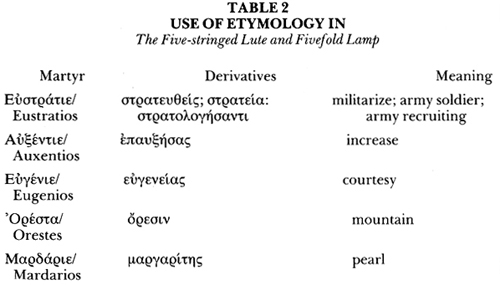
In addition to this word game Kassia also includes a musical motive that represents the  or the five-stringed lute and the five martyrs. The motive is most appropriately that of a pentachord, C-G. Even though this composition is in Mode IV Authentic with a final of G, the ascending and descending C-G motive outlines a type of tonic-dominant relationship. This motive appears in a variety of forms and is outlined with brackets in Example 3. Although a symbol for the five martyrs, the motive is also used as a unifying device for this lengthy work. Typical of Mode IV Authentic, the hymn cadences with the formula BAGG.
or the five-stringed lute and the five martyrs. The motive is most appropriately that of a pentachord, C-G. Even though this composition is in Mode IV Authentic with a final of G, the ascending and descending C-G motive outlines a type of tonic-dominant relationship. This motive appears in a variety of forms and is outlined with brackets in Example 3. Although a symbol for the five martyrs, the motive is also used as a unifying device for this lengthy work. Typical of Mode IV Authentic, the hymn cadences with the formula BAGG.
The final hymn for discussion is Kassia's most famous composition, her Troparion The Fallen Woman (No. 3 in Table 1), which is sung in the morning office of Holy Wednesday. This composition, written after Kassia had entered the monastic life, may be autobiographical or at the least a perception of her inner feelings. According to legend and documentation, Emperor Theophilos regretted not choosing Kassia for his bride and attempted later to meet her and express his sorrow and love. Although Kassia avoided the emperor, she felt in her heart that she had returned his love and had become a "fallen woman."22
For the most part the melody and text is Kassia's, but verse eight of the poem is attributed to Theophilos. Supposedly Kassia was in the midst of writing this poem when the emperor made one of his stately visits to her monastery which was located outside Constantinople. Seeing Theophilos from afar, Kassia fled, leaving the poem on her desk. It was this action which inspired Theophilos to add the verse, "Thy feet, whereof when Eve in Paradise heard the sound, she hid herself for fear."23 After his departure Kassia returned to complete her poem and found the addition. Although out of context to the theme of a fallen woman, she retained the emperor's verse; hence it is this pseudo-historical element which has made this hymn so well-known.
The hymn is composed in Mode IV Plagal but is an unusual example for that mode. As can be seen from Example 4, the chant is lengthy and is primarily a syllabic setting but with some neumatic sections.
Example 4: "The Fallen Woman"
| Mode IV Plagal | Transcription from Athens MS. 883, f. 261v by D. Touliatos-Banker |
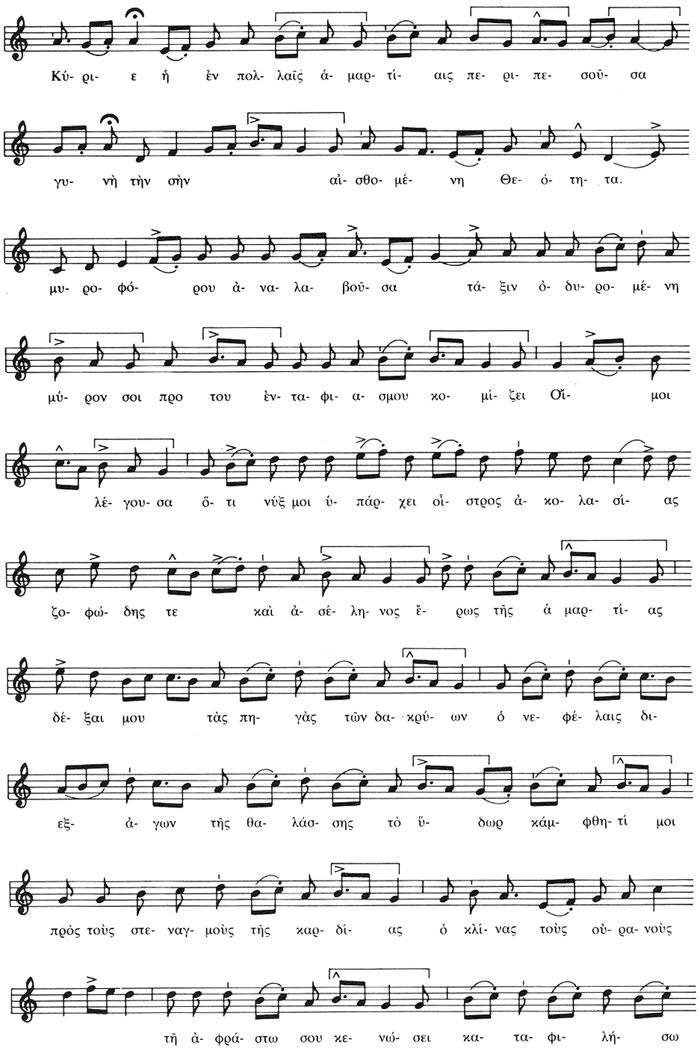
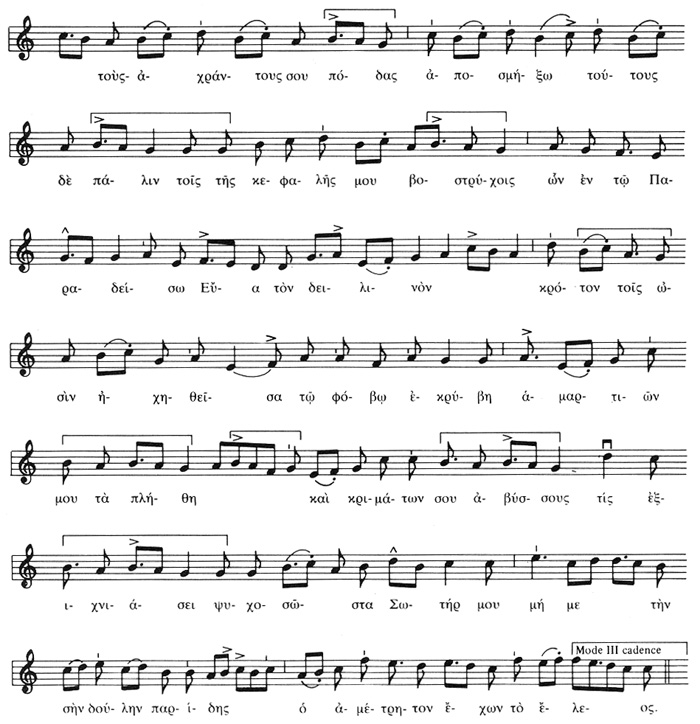
"Lord, the woman fallen in many sins, seeing Thy Divinity,
Taking the part of myrrh-bearer, wailing bringeth to Thee myrrh
against Thy burial.
Alas, she crieth, for that night is to me the wildness of sin, dusky
and moonless, even the love of transgression.
Accept the springs of my tears, who with clouds partest the
waters of the sea:
Bend to the groanings of my heart, who hast brought down Heaven
by Thine ineffable humiliation.
I will kiss again Thy stainless feet,
I will wipe them then with the hair of my head—
Thy feet, whereof when Eve in Paradise heard the sound, she
hid herself for fear.
The multitude of my sins, and the depths of Thy judgment who
shall explore, Savior of souls, my Redeemer.
Forget not me Thy servant, Thou, whose mercy is infinite."
Translation: H.J.W. Tillyard
The melody has an exceptionally wide ambitus of an octave and a fourth, from c' to f '', which lies between the Fourth Plagal and Fourth Authentic Modes. Common to both modes, the motive BAG and its variants occur throughout the chant and are marked with brackets. Unusual to both modes, however, is the final cadence FEDCC, which is a formula for Mode III Authentic.
Because of its fame, this hymn has been arranged by composers of Byzantine music later than Kassia, such as Bishop Germanos, Nicholas of Smyrna, Petros Peloponessios, Theodore Phocaeus, Emmanuel Vamvoudhakis, and Ioannes Sakellarides.24 Although most of these composers have included new passages, some have also retained portions of Kassia's original melody. More recently three- and four-part arrangements of the hymn have been published.25 It is indeed a tribute to this woman composer that her liturgical compositions continue to be performed in the services of the present-day Greek Orthodox Church and that the Byzantine technique of arranging a traditional melody by later composers continues to be practiced with her compositions.
| * | * | * |
After this article was already in proof, I discovered three other women composers of Byzantine chant:
- Martha—mother of Symeon the Stylite and abbess of a nunnery at Argos toward the end of the ninth century,26
- Thekla—a nun who lived around the ninth century and is known for her composition of kanons,27
- Kouvouklisena—a woman domesticos and probable composer cited in Lavra MS. Γ 71.28
Although no music remains for these three women, they are documented in sources as composers of Byzantine chant and are a welcome addition to the two women composers already discussed in this article.
1The following are a few of the recent studies on composers of Byzantine music: Milo Velimirovic, "Two Composers of Byzantine Music: John Vatatzes and John Laskaris," Gustave Reese Festschrift 1966: Aspects of Medieval and Renaissance Music (New York: W.W. Norton, 1965), pp. 818-31; idem, "Byzantine Composers in MS. Athens 2406," Essays Presented to Egon Wellesz, ed. by Jack Westrup (Oxford: Clarendon Press, 1966), pp. 7-18; idem, "The Musical Works of Theoleptos, Metropolitan of Philadelphia," Studies in Eastern Chant II (London: Oxford University Press, 1971), 155-65; Dimitrije Stefanovic and Milo Velimirovic, "Peter Lampadarios and Metropolitan Serafim of Bosnia," Studies in Eastern Chant I (London: Oxford University Press, 1966), 67-88; Christos Patrinelis, "Protopsaltae, Lampadarii, and Domestikoi of the Great Church during the Post-Byzantine Period (1453-1821)," Studies in Eastern Chant III (London: Oxford University Press, 1973), 141-70; Andrija Jakovljevic, "Two Stichera with Byzantine Notation of Philotheos, Patriarch of Constantinople," Byzantine Studies I, 1 (1974), 54-64.
2The most extensive study on Ioannes Koukouzeles is Edward V. Williams' "John Koukouzeles' Reform of Byzantine Chanting for Great Vespers in the Fourteenth Century" (Ph.D. dissertation, Yale University, 1968).
3The only study on Manuel Chrysaphes is that of A. Papadopoulos-Kerameus'  Vizantiiskii Vremennik VIII (1901), 526-45.
Vizantiiskii Vremennik VIII (1901), 526-45.
4Athens MS. 2406, fol. 258v: 
5An example of this would be an inscription to Manuel Korones, who is identified as the son of Xenos Korones, or to Agathon Korones, who is the brother of Xenos Korones.
6Velimirovic, "Byzantine Composers in MS. Athens 2406," p. 12.
7George Papadopoulos,  (Athens:
(Athens:  , 1890), pp. 274-75.
, 1890), pp. 274-75.
8In his study Krumbacher indicates that the forms  and
and  were probably due to scribal error. Cf. Karl Krumbacher, "Kasia," Sitzungsberichte der bayrischen Akademie der Wissenschaften (1897), pp. 316-317. In modern Greek literature authors have referred to her as
were probably due to scribal error. Cf. Karl Krumbacher, "Kasia," Sitzungsberichte der bayrischen Akademie der Wissenschaften (1897), pp. 316-317. In modern Greek literature authors have referred to her as  . Also cf. Ilse Rochow, Studien zu der Person, den Werken und dem Nachleben der Dichterin Kassia (Berlin: Akademie-Verlag, 1967), p. 3; Egon Wellesz, "Die Rhythmik der byzantinischen Neumen, II. Die hymnen der Kasia," Zeitschrift für Musikwissenschaft III (Oct., 1920-Sept., 1921), 321. Hans-Georg Beck, Kirche und Theologische Literatur im Byzantinischen Reich (Byzantinisches Handbuch im Rahmen des Handbuchs der Altertumswissenschaft XII/2.1) (München: C.H. Beck'sche Verlagsbuchhandlung, 1959), 519.
. Also cf. Ilse Rochow, Studien zu der Person, den Werken und dem Nachleben der Dichterin Kassia (Berlin: Akademie-Verlag, 1967), p. 3; Egon Wellesz, "Die Rhythmik der byzantinischen Neumen, II. Die hymnen der Kasia," Zeitschrift für Musikwissenschaft III (Oct., 1920-Sept., 1921), 321. Hans-Georg Beck, Kirche und Theologische Literatur im Byzantinischen Reich (Byzantinisches Handbuch im Rahmen des Handbuchs der Altertumswissenschaft XII/2.1) (München: C.H. Beck'sche Verlagsbuchhandlung, 1959), 519.
9Edward Gibbon, The History of the Decline and Fall of the Roman Empire, with notes by the Rev. H.H. Milman, V vols. (New York: Hooper, Clarke & Co., 1886), IV, 204. Also, read J.B. Bury's A History of the Eastern Roman Empire from the Fall of Irene to the Accession of Basil I (New York: Russell & Russell Inc., 1965), pp. 81-83.
10K. Krumbacher, Geschichte der byzantinischen Litteratur von Justinian bis zum Ende des oströmischen Reiches (527-1453) (Handbuch der klassischen Altertumswissenschaft IX, 1) (München: C.H. Beck'sche Verlagsbuchhandlung, 1897), 715; G. Krüger, "Kassia, Kasia," Real-Enzyklopädie für protestantische Theologie und Kirche X (1901), 112; Papadopoulos, 
 , pp. 251-52. Rochow gives the birth date between 800-805. Cf. Rochow, Studien zu der Person, p. 26.
, pp. 251-52. Rochow gives the birth date between 800-805. Cf. Rochow, Studien zu der Person, p. 26.
11Rochow, Studien zu der Person, pp. 59-72.
12Egon Wellesz, A History of Byzantine Music and Hymnography, 2nd edition (Oxford: Clarendon Press, 1961), pp. 181-182.
13H.J.W. Tillyard, "A Musical Study of the Hymns of Casia," Byzantinische Zeitschrift XX (1911), 422. Also, cf. Paul Maas, "Metrisches zu den Sentenzen der Kassia," Byzantinische Zeitschrift X (1901), 54.
14Tillyard, "A Musical Study of the Hymns of Casia," pp. 422-23; Wellesz, A History of Byzantine Music, p. 237.
15Rochow, Studien zu der Person, pp. 47-55.
16For the different types of Stichera, see Wellesz's A History of Byzantine Music, pp. 243-45.
17Krumbacher, "Kasia," pp. 347-56.
18This idea is postulated by Kenneth Levy in his article: "A Hymn for Thursday in Holy Week," Journal of the American Musicological Society XVI (Summer, 1963), 127-75. Cf. Dimitri Conomos, Byzantine Trisagia and Cheroubika of the Fourteenth and Fifteenth Centuries (Thessaloniki: Patriarchal Institute for Patristic Studies, 1974), p. 56. Also, it should be pointed out that the composition by the daughter of Ioannes Kladas was in Mode IV Authentic.
19Rochow, Studien zu der Person, pp. 3-55; Tillyard, "A Musical Study of the Hymns of Casia," pp. 420-485.
20S.A. Kirpitschnikow, "Eine volkstümliche Kaiserchronik," Byzantinische Zeitschrift I (1892), 306.
21Gustave Reese, Music in the Middle Ages (New York: W.W. Norton, 1940), p. 82. Cf. A. Gastoué, "Les types byzantins de la Séquence," La Tribune de St. Gervais XXIV (1922), 1-6.
22P. Sophrone Pétridès, "Cassia," Revue de l'Orient Chrétien VII (1902), 227-28; L. Petit, "Notes d'histoire littéraire. I. A propos des pièces liturgiques de Cassia," Byzantinische Zeitschrift VII (1898), 594-97. Kassia could possibly have been inspired to write this hymn from reading St. Luke 7:36 about the sinner woman. Jørgen Raasted, "Voice and Verse in a Troparion of Cassia," Studies in Eastern Chant III (1973), 171-78.
23Petit, "Notes d'histoire littéraire," pp. 594-95.
24Tillyard, "A Musical Study of the Hymns of Casia," pp. 465-72.
25Ioannes Sakellarides has arranged the hymn for three-part singing as well as unison. A four-part setting has been arranged by Nicholas Mantzaros, the composer of the present-day Greek national anthem, and another by Athan P. Theodores.
26C. Émereau, "Hymnographi Byzantini," Echos d'Orient XXIII (1924), 409.
27George Papadopoulos,  (Athens, 1890), p. 253.
(Athens, 1890), p. 253.
28Sophronios Eustratiades,  (Paris, 1925), p. 42.
(Paris, 1925), p. 42.


